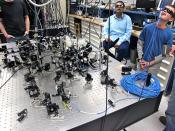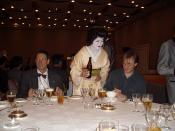Photonic band gap materials are solids that strongly diffract light, ideally at visible and near-infrared wavelengths. They are ordered dielectric structures, such as silica-air or titania-polymer, with sub-micron periodic length scales. Many exciting applications have been proposed for these materials, including cavities for thresholdless lasing, planar waveguiding, and photon localization. Our group's efforts in this area began only in 1998, when graduate student Peng Jiang began to explore better ways to form silica colloidal films. Since then the project has expanded exponentially both within our own group as well as in the larger community. Much of our work in this area is done in collaboration with Dr. Dan Mittleman from Electrical Engineering and Computer Science.
Current research efforts are focused on the interesting ways in which light propagates within microfabricated high-contrast periodic dielectric and metallic structures. The use of periodic structures to engineer electromagnetic wave propagation has a rich history dating back to some of the early work on microwave radar technologies during the Second World War and more recently to the design of Distributed Feedback Lasers and Fiber Bragg Gratings which have become integral components of the fiber-optic telecommunication industry.
Today these ideas have been reborn in the form of photonic bandgap (PBG) materials or photonic crystals (PC), in which high-contrast periodic dielectric and metallic structures are used to create such strong dispersion as to open up frequency windows within which the propagation of light is entirely forbidden.
This new focus on optical PBG materials has spawned a great deal of interest in work on the control of light emission from materials placed within PBG structures. It has long been realized that the spontaneous emission of radiation from an excited state of matter depends critically upon the electromagnetic environment in which it is placed. One may thus imagine using...


